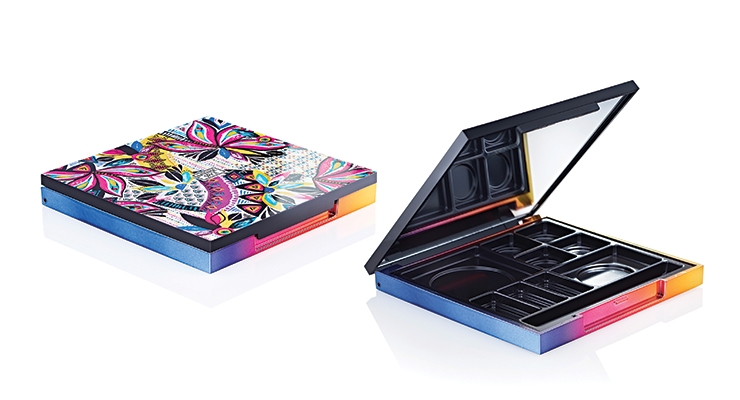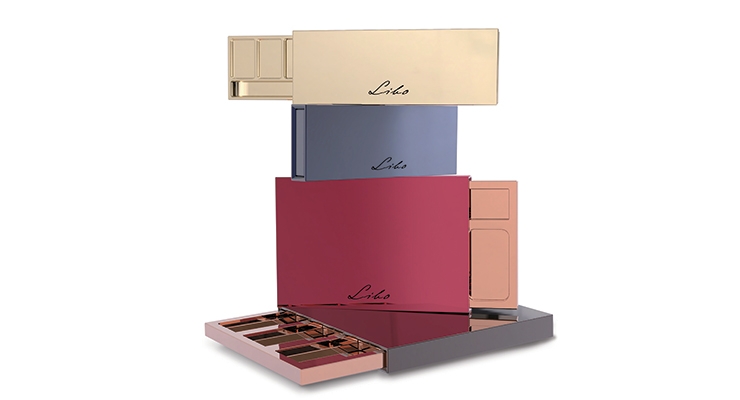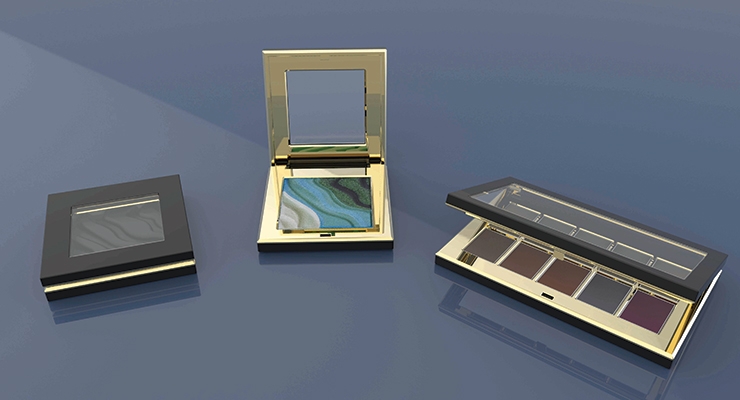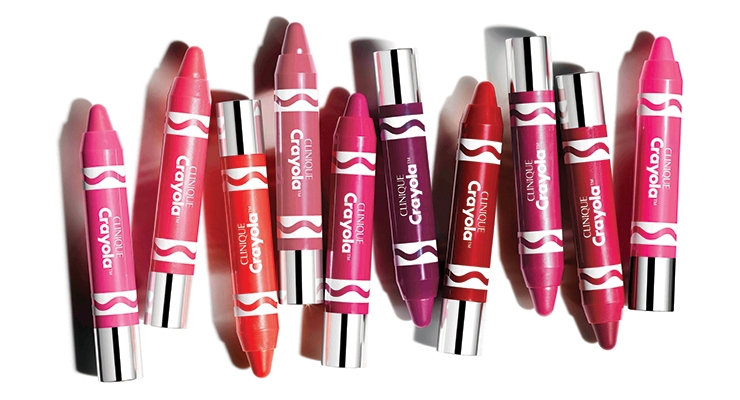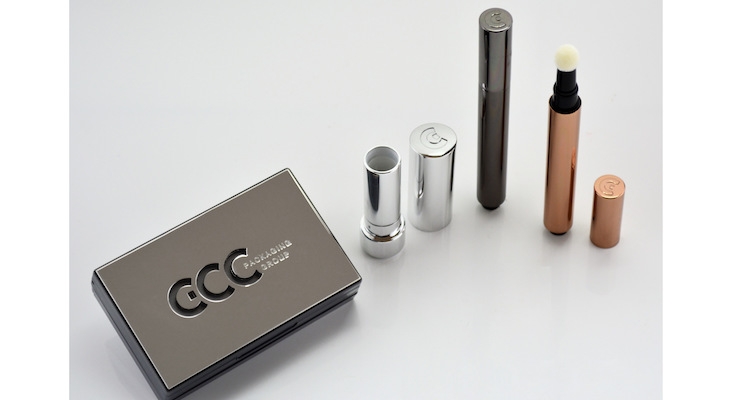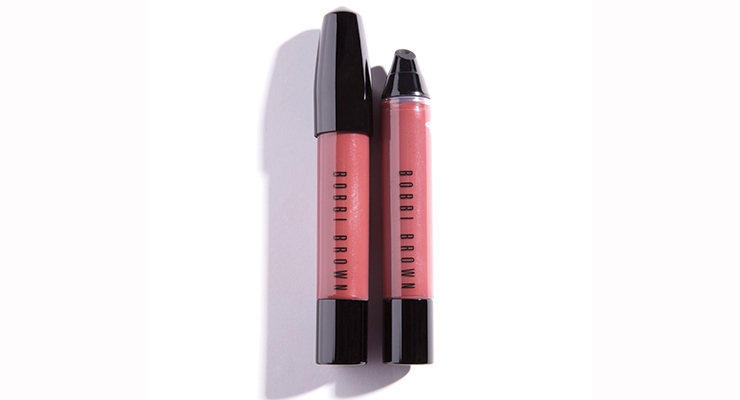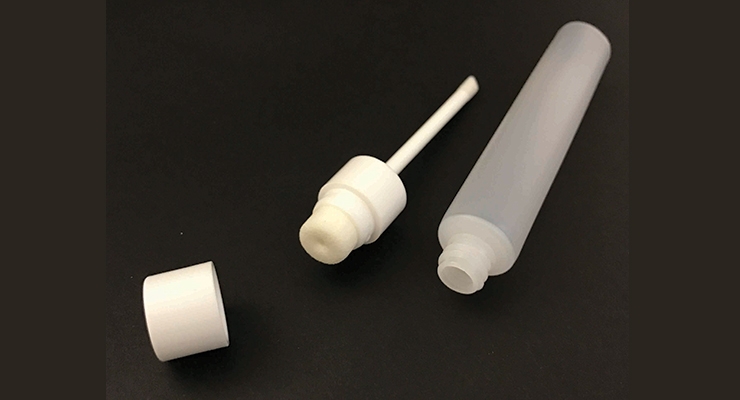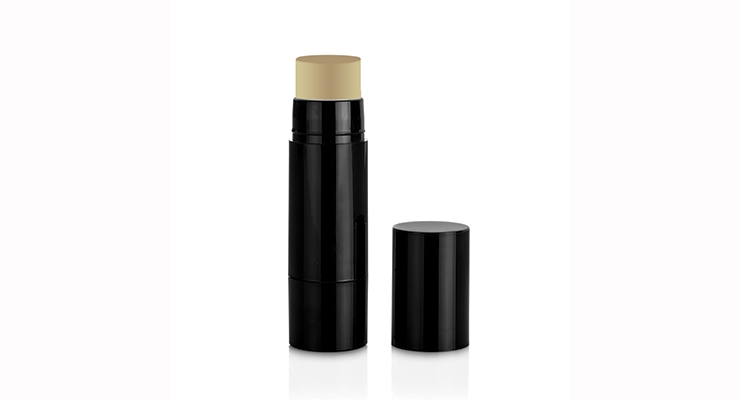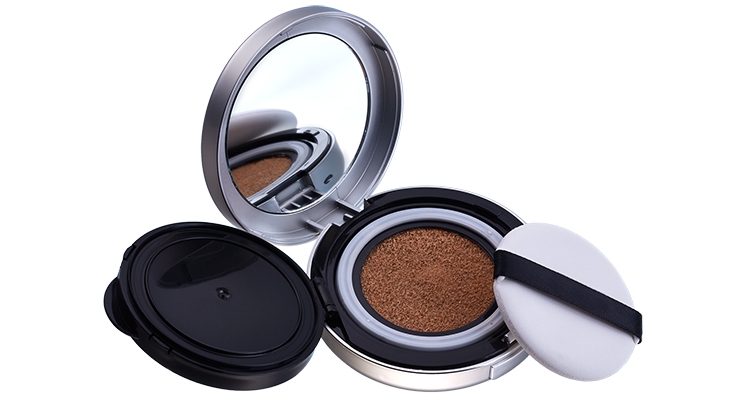Marie Redding, Associate Editor03.03.17
Consumers want makeup that is simple to apply and easy to carry around, marketers say. Brands are working with suppliers to develop packaging that gives all types of color cosmetics these functional features, and more.
“The market is demanding ‘smarter’ packaging,” says Sonia Cerato, makeup category manager, Quadpack Industries. “That’s a term we use to describe packages that add value to a formula, in more ways than one,” she explains. “Added features, such as packages that offer formula protection or integrated applicators are examples,” she says.
Jim Farley, executive vice president of global business development, World Wide Packaging (WWP), agrees, saying, “We continue to receive requests for package differentiation, as well as performance enhancements.”
Color cosmetics are expected to do more, and work better. “Everyone wants pixel-perfect, selfie-ready skin,” says Michele Robertson, director of product development and marketing, Kolmar Laboratories. Robertson gives a few examples, saying, “There are color-correcting cushion compacts, contouring cream-to-powders, and strobing pressed powder illuminators on the market. These products, as well as new makeup application techniques such as blush-draping, are enabling the consumer to sculpt and correct their way to a perfect canvas.”
As color cosmetic formulas evolve, packaging is evolving as well. “Components have to keep up with the formulators, who are being asked to create more novel and innovative makeup products,” Robertson says.
Suppliers also say more brands are requesting dual-use and double-ended packages—as well as packages with integrated applicators for easy, on-the-go application. Rick Persons, president, Derik Industrial USA, says he hears more requests for packages that are designed for “dual-use.” He explains, “Our packages that offer dual functionality, such as combining a formula with a blending tool, are in great demand.”
Curtis Altmann, who consults on global development for Yonwoo/PKG, agrees, saying, “We continually hear requests from brands for packaging that offers two different ways to apply a cosmetic product, so it will serve a dual purpose.”
Miniature-size packages are also in demand, suppliers say. “Customers are often looking for “on the go” packaging,” says Colin Philips, general manager, MYC Packaging.
Quadpack’s Cerato also says that more brands are requesting smaller sizes. “Airplane-friendly packaging is in demand, which is slightly larger than minis,” she says. “These also must be air-tight and leak-proof,” she adds.
Stephanie Rowntree, product manager, HCP Packaging, says, “Mini packs are popular, especially for lip color and limited edition sets. The constant surge in Travel Retail is fueling the demand for smaller size packages, but vloggers are as well.” She explains, “More consumers want the latest products and colors the moment they launch. Minis are the perfect solution to satisfy the ‘thirst of the moment.’ ” HCP has Mini Lipsticks in a round format in various cup sizes, with plastic or aluminum cases.
Lindsay Bailey, director of account operations, HCT Packaging, says she gets more requests for more frequent, quick-to-market launches, in a wider array of color options than ever before. “This is especially true for the lip category,” she says. “Liquid lip products that are being offered in a wide variety of shades and finishes have been extremely successful for brands,” she says.
Pretty Palettes & Compacts
The “all-in-one” palette is another trend, according to HCP’s Rowntree. “Brands are requesting this type of palette that can hold many products, for a complete makeup look. The more products or colors that can fit, the better,” she says. An “all-in-one” palette is designed with wells to hold makeup products for the face, cheeks, brows, eyes, and lips.
HCP’s decorative Fusion Grande palette (shown) includes a mosaic insert designed to hold a variety of different products. The supplier is also developing two new large size palettes, the Radii Square Grande and Radii Rectangular Palette. “Both options will be ready to launch soon, in different formats to accommodate a variety of products,” says Rowntree.
HCP is also getting ready to debut four new design trends for cosmetic packaging at the Cosmoprof Bologna show in March 2017—Crystal Skies, Fever, Serenity, and Jetset. “We launch seasonal ranges, twice a year, to showcase our new stock packages and finishes,” says Rowntree. HCP’s stock ranges include its Magni Pots and Fusion Glass ranges.
Libo just introduced a new design, its patented Magna Match Palettes, available in different shapes and sizes. The palettes look stylish with a shiny metallized finish. They open by sliding the bottom portion out from the outer sleeve. Designed to be easily customized, the palette can be used with various types of inserts. “It has a magnetic closure which opens and closes with only one push,” says Sammi Du, Libo.
World Wide Packaging offers an innovative range of packages that will hold several products, called Collision Compacts. They are designed with a hidden clasp, for a sleek, elegant look. “This compact line can be configured with a variety of well and pan configurations,” says WWP’s Farley. “They offer sleek styling with a colored 45-degree reveal along the parting surfaces, and a shade window that allows for full product visibility, as well as customization,” he says.
WWP offers its Collision Compacts as a complete custom line, or they can be designed individually to meet a brand’s specific requirements. “We can also enhance a product to work with the shade window feature,” says Farley.
One of GCC’s latest packaging innovations is its Zamak compact. It is a cosmetic compact case decorated with zinc alloy metal plate on top as decoration. Zamak can be electroplated, wet painted, and chromate conversion coated. (It is shown above, with more of GCC’s luxe metal packaging.)
Metal top plates to add elegance, according to GCC. The supplier has the ability to combine several printing techniques, along with a metal plate, to achieve the desired visual effect.
Lip Color Innovations
Social media recently influenced an unexpected partnership, between Clinique and Crayola. The hashtag, #CrayolaMakeupChallenge, made headlines last summer when bloggers and YouTube stars began showing beauty fans how to make Crayola’s crayons, colored pencils, and colored chalk work as makeup. (Crayola quickly posted a warning on its website about this unintended use.)
Now, Clinique has partnered with Crayola to give beauty fans what they wanted, in a safer way. Clinique launched Crayola Chubby Sticks for Lips in January—to “awaken feelings of nostalgia and memories of childhood filled with playtime and creativity,” the press release states. The limited edition collection includes a set of 8 lip colors lined up inside a carton that is modeled after the shape of the box that holds Crayola’s 64-pack of crayons. (Take a look at it in the Online Exclusive at BeautyPackaging.com).
The lip colors were color-matched to actual Crayola crayons, and some have the same names. The collection includes Mauvelous, Razzmatazz, Mango Tango and Tickle Me Pink. The Crayola Chubby Sticks’ package is nearly identical to Clinique’s existing Chubby Sticks for Lips, except these feature Crayola’s logo on the side and trademark squiggly line detail.
It seems like Bobbi Brown Cosmetics’ recent inspiration was art school with its launch of Art Stick Liquid Lip, which will launch in 16 different colors this spring. The team at Bobbi Brown worked with HCT Packaging. “It’s a fun twist on a standard lipgloss tube, and has a squeezable body,” says HCT’s Bailey.
The collaboration began when HCT Design Innovation debuted the package at Cosmoprof Bologna in 2015, according to Bailey. “Our ‘Chubby Stick’ gave the team at Bobbi Brown the opportunity to utilize our ready–to-go concept, while tooling a new cap to fall in line with required brand aesthetics,” she explains.
The team at Bobbi Brown chose to use a matte texture in-mold to deposit color on the package’s cap, Bailey explains. “Our stock package is designed with a separate applicator, which gives a brand customization options and flexibility in tailoring its shape and contours to best suit a specific formula,” she explains.
Another supplier with an innovative option for lip color is Quadpack, with its Click Stylo lip color pen. “It delivers the products in a precise dose with one click. Add a slanted bullet, and this pen’s slimline shape allows the product to be applied meticulously, with extreme accuracy. It is also airtight, portable and fun to use,” says Quadpack’s Cerato.
Kolmar’s Robertson says she is also seeing new takes on traditional packaging for lip color. “We see a booming trend in the lip category—the traditional bullet is being replaced with square, diamond, and tear drop shapes,” she says. “This creates a unique visual.”
Robertson says these bullet styles are being requested more often by brands, and they deliver functional benefits as well. “The different shapes adjust to the contours of the lips, making it easier to create different looks, such as an ombre effect,” she says.
When Ingredients Pose Compatibility Issues
Since liquid lip color has become so popular, some suppliers have taken steps to ensure that lip product packaging is compatible with these types of formulations. These products often include additives to achieve a high-shine glossy texture, or a velvet-like finish.
Some brands are using isododecane as an ingredient for lip color, according to Altmann (consultant for Yonwoo/PKG) to achieve the desired texture. “Since this ingredient causes compatibility issues with certain plastics and makes them swell, including PP, we use alternative resins, including nylon, to accommodate these types of formulations.”
Walter Dwyer, Cosmopak, also mentions ingredients, telling us that in addition to concerns over formulations, more brands—and consumers—are increasingly aware of the ingredients used in manufacturing plastic packaging components. Dwyer says that BPA, for example, is no longer acceptable for some brands that have “blacklisted” all resins that contain it.
“There is a movement toward the use of more natural ingredients, in formulations as well as in packaging. This often poses challenges, because a brand will sometimes request a certain container shape, but it is made in a material they don’t want to use,” says Dwyer. “We have had many brands come to us recently with specific guidelines that are more stringent than ever,” he adds.
Since Cosmopak partners with various factories, Dwyer says the company is equipped to accommodate these types of requests. “We will locate a package in the shape a brand requests, and then partner with a factory to manufacture it in the material they want,” he says.
Packages with Integrated Applicators
Beauty fans that watch YouTube tutorials are more skilled in blending, and these makeup application techniques require the right brushes and applicators. Brands are working with suppliers to develop more ways to integrate applicators, making them part of a package.
“Brands are looking for packages that act as self-contained units—with the formula on one end and a brush or sponge on the other,” says Derik’s Persons. He has been working with brands to develop this type of package for stick and liquid products, including foundation sticks, powders, concealers, highlighters, and brow products. “It’s an important added value,” he adds.
Derik Industrial offers several different packages designed to meet this need. “We have a brow pen with a treatment product on one end and a brow comb on the other end. We also have a range of stick packages, in a variety of diameters and lengths, which all come equipped with blending sponges and brush options,” he says.
Quadpack’s Cerato describes its Comb Pen for Brows, saying, “With a click, the formula is dispensed onto the comb’s bristles, and then brushed onto the brows. It is styling and color in one.” The flow-through pen has an integrated comb. “It ticks all the boxes—portability, convenience, precision and engagement in one simple yet professional pack,”
Cerato adds.
Yonwoo/PKG offers a package with two applicators—a 19mm tube that is ideal for lip color or concealer. Both applicators are attached to the same cap, with one on the outside of the tube, and one inside. “The user has the option to apply the product using the flow-through sponge tip applicator on top of the tube. Or, unscrew this tip, then lift it up to remove the wand from inside the tube, and use the doe foot applicator on the end,” says Altmann.
Grace Chiu, managing director, GCC Packaging Group, also says that packages with integrated applicators are very much in demand for color cosmetics. She hears more frequent requests for pens as well as all types of double-ended packages.
GCC has several double-ended options for cosmetics. One of these has a lipstick case on one side, and a lipgloss bottle on the other. Another option pairs mascara with eyeliner. “Brands are looking for ways to offer consumers more convenience, and these packages are designed for multi-tasking,” says Chiu. “We also have a double-ended package that combines a mascara with a brow product,” she adds.
Foundation Makeup Trends
Consumers are looking for foundation makeup products that are easy to apply and travel with, and brands are delivering. Skin care ingredients are also showing up more in makeup formulations.
Lesley Gadomski, business development officer, Fusion Packaging, says, “The lines are blurred between cosmetics and skin care, especially for primers, concealers and foundation products. It is a trend that is continuing to grow.”
Brand marketers like the high evacuation rate that an airless pump offers, Gadomski explains, but this type of package is more often a necessity now, since more makeup products are being formulated with ingredients typically found in skin care.
Urban Decay just launched a line of problem-solving Complexion Primers, in airless packaging by Fusion. The line includes De-Slick, a mattifying formula that will absorb oil, smooth skin, and minimize pores; Self-Adjusting Complexion Primer, a color-correcting primer with encapsulated pigments that adjust to your skin tone and create a soft-focus effect; and Optical Illusion, a matte formula that creates a powdery, airbrushed finish that also has a pink tint for a brightening effect.
The product line is housed in Fusion’s 30ml plastic bottles with airless pump dispensers. “The bottle is one of our stock items, but Urban Decay used it in a non-traditional way—for makeup, rather than skin care,” says Gadomski. “The bottle has a premium aesthetic, with a glass-like clarity,” she adds.
Robertson, of Kolmar Laboratories, says that dual-chamber packages are crossing over from skin care into color cosmetics. “Dual-chambered packaging that allows the consumer to perform a one-time activation after purchasing the product protects the integrity of the actives and ensures efficacy at the time of use,” she says. “This is more relevant now for cosmetics, such as foundation makeup. We are seeing a continuous trend of bridge products that include highly active skin care additives in color cosmetics.”
Vesna Deljosevic, owner & CEO, Reforma Group, also says that adding more active ingredients to cosmetics is a trend. “We have many customers asking us for these types of makeup formulas,” she says. One example Deljosevic mentions is face primers that contain oils. “These are usually best in glass bottles, with dropper caps,” she says.
Reforma Group works with its customers to provide formulation and packaging, turnkey. Deljosevic also says that more brands are looking for brighter colors for eyes and lips, but they want more natural ingredients. “We are hearing more requests for colors that come from nature— beets, for example. Or Alkanet root powder, Gromwell Powder and Hibiscus. Brands, and consumers, want cleaner labels—without having to list dyes as an ingredient,” she says.
More Options for Foundation Makeup
The “selfie trend” is fueling the growth of HD makeup, such as foundations that hide every pore, according to Quadpack’s Cerato. “Brands are optimizing color cosmetic formulations for photography—and packaging is keeping up. Our Maxi Jumbo, for example, gives brands an ideal delivery system for an all-over foundation. It fits in your handbag, and has an integrated sponge.”
Taiki has a Cushion Compact, which is ideal for foundation. It includes a cushion sponge or luxurious puff applicator. Jan Wilson, vice president of sales, Taiki, says, “Our high-end airtight compact is designed to showcase a formulation, beautifully. The cushion compact trend is here to stay,” she adds.
Taiki has also developed a range of low-profile brushes, which are the ideal tools for applying a long-lasting foundation product that is formulated to deliver buildable coverage, according to Wilson.
MYC Packaging is offering a new solution for foundation—its Apply & Go foundation compact. “Ease of application and applicator innovation are key areas of focus for us, and this compact provides both,” says Philips, of MYC Packaging. “It is an ideal solution for a wide range of formulas,” he adds.
Shiny Looks
Many brands are decorating cosmetic packaging with shiny finishes, and brands frequently turn to Anomatic for its expertise in achieving these looks using anodizing or metallization techniques. The supplier often uses metallization to achieve a wide variety of looks, including bright, opaque, translucent or semi-translucent colors. Anomatic decorates all types of cosmetic packages and components, including compacts, palettes, lipstick cases and nail polish caps.
“We just launched a new anodized finish,” says Steve Rusch, vice president, marketing & business development, Anomatic. “It is an iridescent finish that simulates an “oil slick” appearance. As light reflects on the package’s metal parts, such as a closure, it evolves into a different color,” Rusch explains.
Anomatic also recently developed a state-of-the-art vacuum metallization system, which applies a thin layer of metal on top of another material, such as plastic. “We’re one of the only companies in the U.S. using vacuum metallization for the beauty packaging industry,” says Rusch. “We have the ability to custom color match, to anything imaginable,” he adds.
GCC’s Chiu says she is hearing more requests for packages decorated in metallic finishes. “Copper colors are being requested more than ever before,” she says.
“Compacts with clear windows are also ‘in’ again,” says Chiu. GCC is also developing a new lip palette. “One of the largest beauty brands will bring this to market later this year,” says Chiu.
Innovation Lies Ahead
As color cosmetic formulations continue to improve, packaging will change and adapt to accommodate market needs, suppliers say. “Formulas are continuing to become more sophisticated in texture and functionality. I see packaging beginning to evolve as well,” says Kolmar’s Robertson.
As technology advances, Robertson says packaging will become even “smarter.” “Perhaps we’ll see compacts with smart diagnostic mirrors to assess the user’s skin daily,” she says. “The next generation of packaging will surely revolutionize the beauty industry,” she adds.
Reforma Group’s Deljosevic says more innovation lies ahead. “Indie brands are innovating the most. We often work with brands that have a mission to develop completely new types of products and formulations—and it’s an exciting time for makeup,” she says.
It’s an exciting time for packaging as well. Quadpack’s Cerato says it is often the small details that matter most, explaining that a package designer thinks extensively about details such as the click of a pen, or the turn of a lid, to improve the user’s experience. “An interesting gesture, a fun shape, or eye-popping aesthetics—a product must always engage the user,” she says.
Cerato adds that Quadpack is currently working on “sensory makeup,” which she says is “playful and creative packaging that targets the senses, to make consumers fall in love with a product.” She continues, “We’re thinking about bounce-back foundations, suspended glitter lipstick, self-adjusting PH, and shape-shifting formulas. Things are getting very interesting in color cosmetics.”
“The market is demanding ‘smarter’ packaging,” says Sonia Cerato, makeup category manager, Quadpack Industries. “That’s a term we use to describe packages that add value to a formula, in more ways than one,” she explains. “Added features, such as packages that offer formula protection or integrated applicators are examples,” she says.
Jim Farley, executive vice president of global business development, World Wide Packaging (WWP), agrees, saying, “We continue to receive requests for package differentiation, as well as performance enhancements.”
Color cosmetics are expected to do more, and work better. “Everyone wants pixel-perfect, selfie-ready skin,” says Michele Robertson, director of product development and marketing, Kolmar Laboratories. Robertson gives a few examples, saying, “There are color-correcting cushion compacts, contouring cream-to-powders, and strobing pressed powder illuminators on the market. These products, as well as new makeup application techniques such as blush-draping, are enabling the consumer to sculpt and correct their way to a perfect canvas.”
As color cosmetic formulas evolve, packaging is evolving as well. “Components have to keep up with the formulators, who are being asked to create more novel and innovative makeup products,” Robertson says.
Suppliers also say more brands are requesting dual-use and double-ended packages—as well as packages with integrated applicators for easy, on-the-go application. Rick Persons, president, Derik Industrial USA, says he hears more requests for packages that are designed for “dual-use.” He explains, “Our packages that offer dual functionality, such as combining a formula with a blending tool, are in great demand.”
Curtis Altmann, who consults on global development for Yonwoo/PKG, agrees, saying, “We continually hear requests from brands for packaging that offers two different ways to apply a cosmetic product, so it will serve a dual purpose.”
Miniature-size packages are also in demand, suppliers say. “Customers are often looking for “on the go” packaging,” says Colin Philips, general manager, MYC Packaging.
Quadpack’s Cerato also says that more brands are requesting smaller sizes. “Airplane-friendly packaging is in demand, which is slightly larger than minis,” she says. “These also must be air-tight and leak-proof,” she adds.
Stephanie Rowntree, product manager, HCP Packaging, says, “Mini packs are popular, especially for lip color and limited edition sets. The constant surge in Travel Retail is fueling the demand for smaller size packages, but vloggers are as well.” She explains, “More consumers want the latest products and colors the moment they launch. Minis are the perfect solution to satisfy the ‘thirst of the moment.’ ” HCP has Mini Lipsticks in a round format in various cup sizes, with plastic or aluminum cases.
Lindsay Bailey, director of account operations, HCT Packaging, says she gets more requests for more frequent, quick-to-market launches, in a wider array of color options than ever before. “This is especially true for the lip category,” she says. “Liquid lip products that are being offered in a wide variety of shades and finishes have been extremely successful for brands,” she says.
Pretty Palettes & Compacts
The “all-in-one” palette is another trend, according to HCP’s Rowntree. “Brands are requesting this type of palette that can hold many products, for a complete makeup look. The more products or colors that can fit, the better,” she says. An “all-in-one” palette is designed with wells to hold makeup products for the face, cheeks, brows, eyes, and lips.
HCP’s decorative Fusion Grande palette (shown) includes a mosaic insert designed to hold a variety of different products. The supplier is also developing two new large size palettes, the Radii Square Grande and Radii Rectangular Palette. “Both options will be ready to launch soon, in different formats to accommodate a variety of products,” says Rowntree.
HCP is also getting ready to debut four new design trends for cosmetic packaging at the Cosmoprof Bologna show in March 2017—Crystal Skies, Fever, Serenity, and Jetset. “We launch seasonal ranges, twice a year, to showcase our new stock packages and finishes,” says Rowntree. HCP’s stock ranges include its Magni Pots and Fusion Glass ranges.
Libo just introduced a new design, its patented Magna Match Palettes, available in different shapes and sizes. The palettes look stylish with a shiny metallized finish. They open by sliding the bottom portion out from the outer sleeve. Designed to be easily customized, the palette can be used with various types of inserts. “It has a magnetic closure which opens and closes with only one push,” says Sammi Du, Libo.
World Wide Packaging offers an innovative range of packages that will hold several products, called Collision Compacts. They are designed with a hidden clasp, for a sleek, elegant look. “This compact line can be configured with a variety of well and pan configurations,” says WWP’s Farley. “They offer sleek styling with a colored 45-degree reveal along the parting surfaces, and a shade window that allows for full product visibility, as well as customization,” he says.
WWP offers its Collision Compacts as a complete custom line, or they can be designed individually to meet a brand’s specific requirements. “We can also enhance a product to work with the shade window feature,” says Farley.
One of GCC’s latest packaging innovations is its Zamak compact. It is a cosmetic compact case decorated with zinc alloy metal plate on top as decoration. Zamak can be electroplated, wet painted, and chromate conversion coated. (It is shown above, with more of GCC’s luxe metal packaging.)
Metal top plates to add elegance, according to GCC. The supplier has the ability to combine several printing techniques, along with a metal plate, to achieve the desired visual effect.
Lip Color Innovations
Social media recently influenced an unexpected partnership, between Clinique and Crayola. The hashtag, #CrayolaMakeupChallenge, made headlines last summer when bloggers and YouTube stars began showing beauty fans how to make Crayola’s crayons, colored pencils, and colored chalk work as makeup. (Crayola quickly posted a warning on its website about this unintended use.)
Now, Clinique has partnered with Crayola to give beauty fans what they wanted, in a safer way. Clinique launched Crayola Chubby Sticks for Lips in January—to “awaken feelings of nostalgia and memories of childhood filled with playtime and creativity,” the press release states. The limited edition collection includes a set of 8 lip colors lined up inside a carton that is modeled after the shape of the box that holds Crayola’s 64-pack of crayons. (Take a look at it in the Online Exclusive at BeautyPackaging.com).
The lip colors were color-matched to actual Crayola crayons, and some have the same names. The collection includes Mauvelous, Razzmatazz, Mango Tango and Tickle Me Pink. The Crayola Chubby Sticks’ package is nearly identical to Clinique’s existing Chubby Sticks for Lips, except these feature Crayola’s logo on the side and trademark squiggly line detail.
It seems like Bobbi Brown Cosmetics’ recent inspiration was art school with its launch of Art Stick Liquid Lip, which will launch in 16 different colors this spring. The team at Bobbi Brown worked with HCT Packaging. “It’s a fun twist on a standard lipgloss tube, and has a squeezable body,” says HCT’s Bailey.
The collaboration began when HCT Design Innovation debuted the package at Cosmoprof Bologna in 2015, according to Bailey. “Our ‘Chubby Stick’ gave the team at Bobbi Brown the opportunity to utilize our ready–to-go concept, while tooling a new cap to fall in line with required brand aesthetics,” she explains.
The team at Bobbi Brown chose to use a matte texture in-mold to deposit color on the package’s cap, Bailey explains. “Our stock package is designed with a separate applicator, which gives a brand customization options and flexibility in tailoring its shape and contours to best suit a specific formula,” she explains.
Another supplier with an innovative option for lip color is Quadpack, with its Click Stylo lip color pen. “It delivers the products in a precise dose with one click. Add a slanted bullet, and this pen’s slimline shape allows the product to be applied meticulously, with extreme accuracy. It is also airtight, portable and fun to use,” says Quadpack’s Cerato.
Kolmar’s Robertson says she is also seeing new takes on traditional packaging for lip color. “We see a booming trend in the lip category—the traditional bullet is being replaced with square, diamond, and tear drop shapes,” she says. “This creates a unique visual.”
Robertson says these bullet styles are being requested more often by brands, and they deliver functional benefits as well. “The different shapes adjust to the contours of the lips, making it easier to create different looks, such as an ombre effect,” she says.
When Ingredients Pose Compatibility Issues
Since liquid lip color has become so popular, some suppliers have taken steps to ensure that lip product packaging is compatible with these types of formulations. These products often include additives to achieve a high-shine glossy texture, or a velvet-like finish.
Some brands are using isododecane as an ingredient for lip color, according to Altmann (consultant for Yonwoo/PKG) to achieve the desired texture. “Since this ingredient causes compatibility issues with certain plastics and makes them swell, including PP, we use alternative resins, including nylon, to accommodate these types of formulations.”
Walter Dwyer, Cosmopak, also mentions ingredients, telling us that in addition to concerns over formulations, more brands—and consumers—are increasingly aware of the ingredients used in manufacturing plastic packaging components. Dwyer says that BPA, for example, is no longer acceptable for some brands that have “blacklisted” all resins that contain it.
“There is a movement toward the use of more natural ingredients, in formulations as well as in packaging. This often poses challenges, because a brand will sometimes request a certain container shape, but it is made in a material they don’t want to use,” says Dwyer. “We have had many brands come to us recently with specific guidelines that are more stringent than ever,” he adds.
Since Cosmopak partners with various factories, Dwyer says the company is equipped to accommodate these types of requests. “We will locate a package in the shape a brand requests, and then partner with a factory to manufacture it in the material they want,” he says.
Packages with Integrated Applicators
Beauty fans that watch YouTube tutorials are more skilled in blending, and these makeup application techniques require the right brushes and applicators. Brands are working with suppliers to develop more ways to integrate applicators, making them part of a package.
“Brands are looking for packages that act as self-contained units—with the formula on one end and a brush or sponge on the other,” says Derik’s Persons. He has been working with brands to develop this type of package for stick and liquid products, including foundation sticks, powders, concealers, highlighters, and brow products. “It’s an important added value,” he adds.
Derik Industrial offers several different packages designed to meet this need. “We have a brow pen with a treatment product on one end and a brow comb on the other end. We also have a range of stick packages, in a variety of diameters and lengths, which all come equipped with blending sponges and brush options,” he says.
Quadpack’s Cerato describes its Comb Pen for Brows, saying, “With a click, the formula is dispensed onto the comb’s bristles, and then brushed onto the brows. It is styling and color in one.” The flow-through pen has an integrated comb. “It ticks all the boxes—portability, convenience, precision and engagement in one simple yet professional pack,”
Cerato adds.
Yonwoo/PKG offers a package with two applicators—a 19mm tube that is ideal for lip color or concealer. Both applicators are attached to the same cap, with one on the outside of the tube, and one inside. “The user has the option to apply the product using the flow-through sponge tip applicator on top of the tube. Or, unscrew this tip, then lift it up to remove the wand from inside the tube, and use the doe foot applicator on the end,” says Altmann.
Grace Chiu, managing director, GCC Packaging Group, also says that packages with integrated applicators are very much in demand for color cosmetics. She hears more frequent requests for pens as well as all types of double-ended packages.
GCC has several double-ended options for cosmetics. One of these has a lipstick case on one side, and a lipgloss bottle on the other. Another option pairs mascara with eyeliner. “Brands are looking for ways to offer consumers more convenience, and these packages are designed for multi-tasking,” says Chiu. “We also have a double-ended package that combines a mascara with a brow product,” she adds.
Foundation Makeup Trends
Consumers are looking for foundation makeup products that are easy to apply and travel with, and brands are delivering. Skin care ingredients are also showing up more in makeup formulations.
Lesley Gadomski, business development officer, Fusion Packaging, says, “The lines are blurred between cosmetics and skin care, especially for primers, concealers and foundation products. It is a trend that is continuing to grow.”
Brand marketers like the high evacuation rate that an airless pump offers, Gadomski explains, but this type of package is more often a necessity now, since more makeup products are being formulated with ingredients typically found in skin care.
Urban Decay just launched a line of problem-solving Complexion Primers, in airless packaging by Fusion. The line includes De-Slick, a mattifying formula that will absorb oil, smooth skin, and minimize pores; Self-Adjusting Complexion Primer, a color-correcting primer with encapsulated pigments that adjust to your skin tone and create a soft-focus effect; and Optical Illusion, a matte formula that creates a powdery, airbrushed finish that also has a pink tint for a brightening effect.
The product line is housed in Fusion’s 30ml plastic bottles with airless pump dispensers. “The bottle is one of our stock items, but Urban Decay used it in a non-traditional way—for makeup, rather than skin care,” says Gadomski. “The bottle has a premium aesthetic, with a glass-like clarity,” she adds.
Robertson, of Kolmar Laboratories, says that dual-chamber packages are crossing over from skin care into color cosmetics. “Dual-chambered packaging that allows the consumer to perform a one-time activation after purchasing the product protects the integrity of the actives and ensures efficacy at the time of use,” she says. “This is more relevant now for cosmetics, such as foundation makeup. We are seeing a continuous trend of bridge products that include highly active skin care additives in color cosmetics.”
Vesna Deljosevic, owner & CEO, Reforma Group, also says that adding more active ingredients to cosmetics is a trend. “We have many customers asking us for these types of makeup formulas,” she says. One example Deljosevic mentions is face primers that contain oils. “These are usually best in glass bottles, with dropper caps,” she says.
Reforma Group works with its customers to provide formulation and packaging, turnkey. Deljosevic also says that more brands are looking for brighter colors for eyes and lips, but they want more natural ingredients. “We are hearing more requests for colors that come from nature— beets, for example. Or Alkanet root powder, Gromwell Powder and Hibiscus. Brands, and consumers, want cleaner labels—without having to list dyes as an ingredient,” she says.
More Options for Foundation Makeup
The “selfie trend” is fueling the growth of HD makeup, such as foundations that hide every pore, according to Quadpack’s Cerato. “Brands are optimizing color cosmetic formulations for photography—and packaging is keeping up. Our Maxi Jumbo, for example, gives brands an ideal delivery system for an all-over foundation. It fits in your handbag, and has an integrated sponge.”
Taiki has a Cushion Compact, which is ideal for foundation. It includes a cushion sponge or luxurious puff applicator. Jan Wilson, vice president of sales, Taiki, says, “Our high-end airtight compact is designed to showcase a formulation, beautifully. The cushion compact trend is here to stay,” she adds.
Taiki has also developed a range of low-profile brushes, which are the ideal tools for applying a long-lasting foundation product that is formulated to deliver buildable coverage, according to Wilson.
MYC Packaging is offering a new solution for foundation—its Apply & Go foundation compact. “Ease of application and applicator innovation are key areas of focus for us, and this compact provides both,” says Philips, of MYC Packaging. “It is an ideal solution for a wide range of formulas,” he adds.
Shiny Looks
Many brands are decorating cosmetic packaging with shiny finishes, and brands frequently turn to Anomatic for its expertise in achieving these looks using anodizing or metallization techniques. The supplier often uses metallization to achieve a wide variety of looks, including bright, opaque, translucent or semi-translucent colors. Anomatic decorates all types of cosmetic packages and components, including compacts, palettes, lipstick cases and nail polish caps.
“We just launched a new anodized finish,” says Steve Rusch, vice president, marketing & business development, Anomatic. “It is an iridescent finish that simulates an “oil slick” appearance. As light reflects on the package’s metal parts, such as a closure, it evolves into a different color,” Rusch explains.
Anomatic also recently developed a state-of-the-art vacuum metallization system, which applies a thin layer of metal on top of another material, such as plastic. “We’re one of the only companies in the U.S. using vacuum metallization for the beauty packaging industry,” says Rusch. “We have the ability to custom color match, to anything imaginable,” he adds.
GCC’s Chiu says she is hearing more requests for packages decorated in metallic finishes. “Copper colors are being requested more than ever before,” she says.
“Compacts with clear windows are also ‘in’ again,” says Chiu. GCC is also developing a new lip palette. “One of the largest beauty brands will bring this to market later this year,” says Chiu.
Innovation Lies Ahead
As color cosmetic formulations continue to improve, packaging will change and adapt to accommodate market needs, suppliers say. “Formulas are continuing to become more sophisticated in texture and functionality. I see packaging beginning to evolve as well,” says Kolmar’s Robertson.
As technology advances, Robertson says packaging will become even “smarter.” “Perhaps we’ll see compacts with smart diagnostic mirrors to assess the user’s skin daily,” she says. “The next generation of packaging will surely revolutionize the beauty industry,” she adds.
Reforma Group’s Deljosevic says more innovation lies ahead. “Indie brands are innovating the most. We often work with brands that have a mission to develop completely new types of products and formulations—and it’s an exciting time for makeup,” she says.
It’s an exciting time for packaging as well. Quadpack’s Cerato says it is often the small details that matter most, explaining that a package designer thinks extensively about details such as the click of a pen, or the turn of a lid, to improve the user’s experience. “An interesting gesture, a fun shape, or eye-popping aesthetics—a product must always engage the user,” she says.
Cerato adds that Quadpack is currently working on “sensory makeup,” which she says is “playful and creative packaging that targets the senses, to make consumers fall in love with a product.” She continues, “We’re thinking about bounce-back foundations, suspended glitter lipstick, self-adjusting PH, and shape-shifting formulas. Things are getting very interesting in color cosmetics.”

